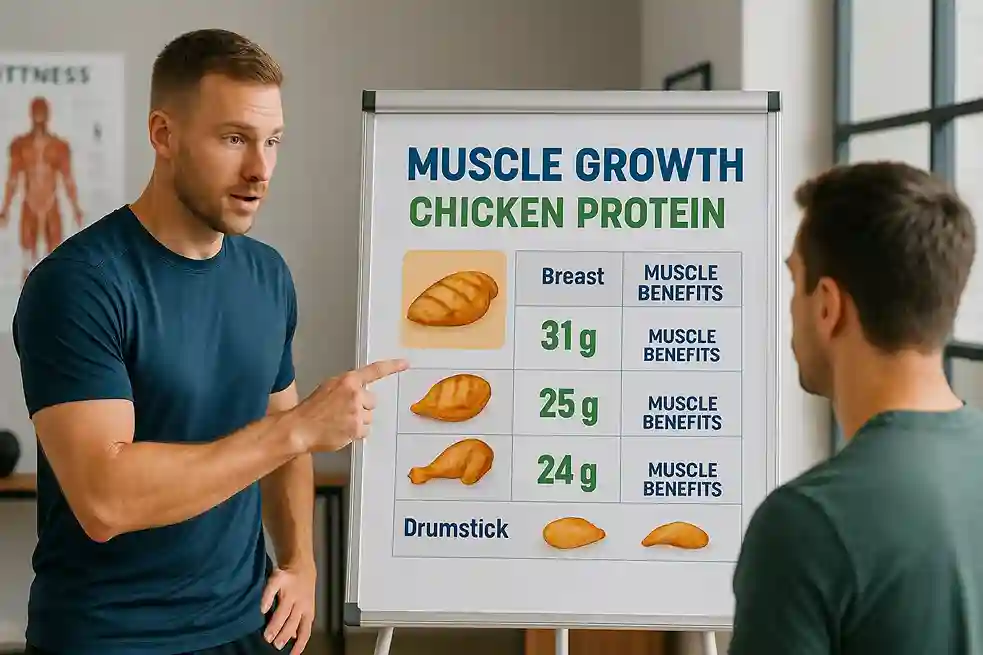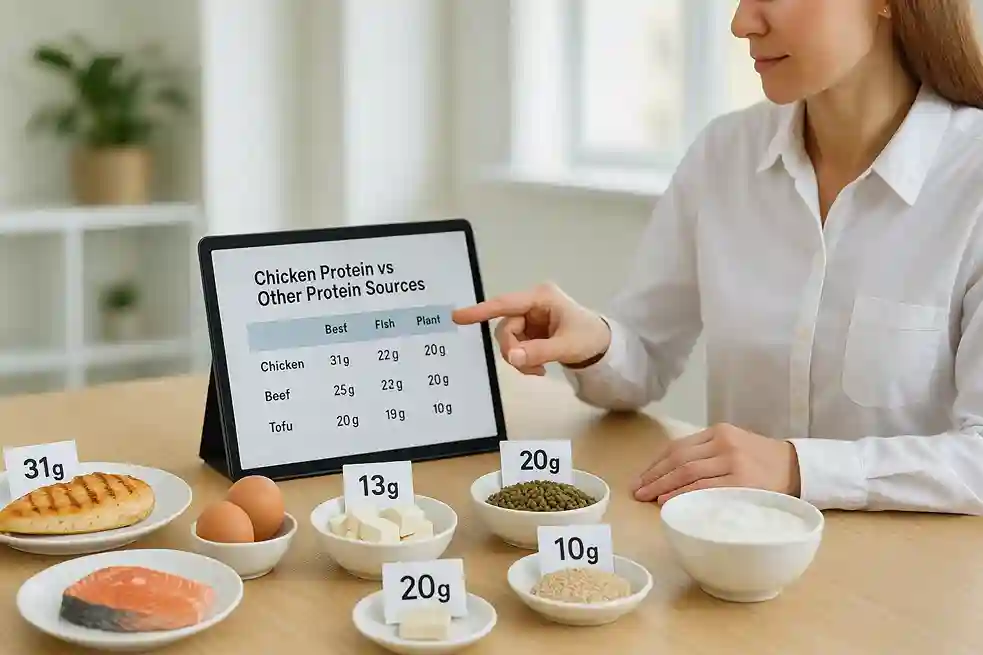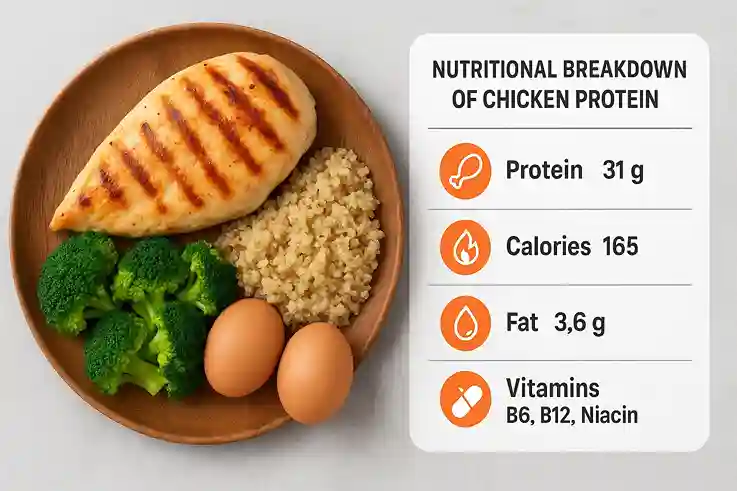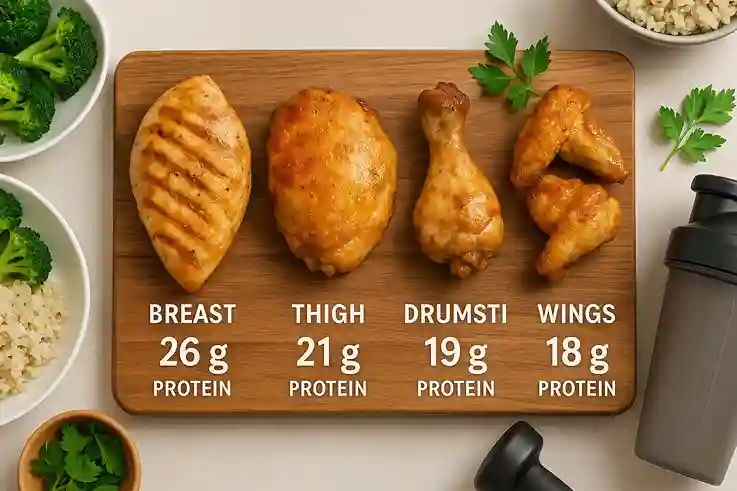Chicken Protein is one of the most reliable fuels for muscle growth and recovery. Athletes and fitness enthusiasts trust it daily. It consistently ranks as a top protein source for building lean muscle. Moreover, it fits easily into many diets, from weight loss to performance-based plans.
Chicken is affordable, widely available, and simple to cook. This makes it a practical option for people at any fitness level. Beyond convenience, Chicken Protein offers a complete amino acid profile. These amino acids repair muscles after workouts and support long-term growth. Therefore, including chicken in meals can accelerate strength and recovery.
A serving of skinless chicken breast provides high protein with minimal fat. In addition, it contains vitamins like B6 and niacin, which aid energy metabolism. Essential minerals such as phosphorus and selenium also support bone health and immunity. Thus, Chicken Protein plays a dual role in both performance and wellness.
Fitness communities often celebrate its versatility. You can grill, bake, or stir-fry chicken while still preserving its nutritional strength. Whether in a salad, wrap, or main dish, Chicken Protein adapts. Ultimately, it stands as a nutrient-dense cornerstone for anyone aiming to build muscle while maintaining balance in their diet.
Why Chicken Protein Matters for Muscle Growth

Chicken Protein is a complete protein source. It contains all nine essential amino acids required for muscle repair and growth. These amino acids are not produced by the body. Therefore, they must come from food, making chicken an excellent choice.
Leucine, isoleucine, and valine are especially important. They belong to the branched-chain amino acids (BCAAs) that directly stimulate muscle protein synthesis. Moreover, they reduce muscle breakdown during intense exercise. This makes Chicken Protein a reliable fuel for both strength and endurance athletes.
Unlike higher-fat meats, chicken offers lean protein with fewer calories. This helps athletes build muscle without excessive fat gain. A skinless chicken breast, for instance, delivers about 26 grams of protein per 3-ounce serving. However, it contains only minimal fat, making it efficient for clean bulking or weight management.
The high digestibility of Chicken Protein ensures quick absorption. As a result, muscles recover faster after demanding workouts. This reduces soreness and improves readiness for the next training session. Therefore, consistent intake of chicken supports both immediate recovery and long-term strength goals.
In summary, Chicken Protein provides the amino acids, digestibility, and lean nutrition needed to maximize muscle growth and performance.
“Lean proteins like chicken provide essential amino acids that support muscle repair, recovery, and overall body composition.” – Academy of Nutrition and Dietetics
Chicken Protein vs Other Protein Sources
When choosing protein, people often compare chicken, beef, fish, and plants. Each source offers unique benefits, but differences matter for results. Chicken Protein stands out for its balance of quality, digestibility, and lean nutrition.
Chicken vs Beef
Beef is protein-rich, but it often contains more saturated fat. This can increase calorie intake and affect heart health. Chicken Protein provides similar amounts of protein with much less fat. Moreover, chicken digests faster, giving muscles quicker access to amino acids. Beef has extra iron and zinc, but chicken remains the leaner option for athletes focused on clean gains.
| Source | Protein (per 3 oz) | Fat | Key Benefit |
|---|---|---|---|
| Chicken | 26g | 2-3g | Lean, fast digestion |
| Beef | 25g | 8-10g | Iron, zinc |

Chicken vs Fish
Fish offers protein plus healthy omega-3 fatty acids. These fats reduce inflammation and support joint health. However, not everyone enjoys fish or cooks it often. Chicken Protein is easier to prepare daily, making it more practical. It has no omega-3s, but it consistently supplies complete protein with low fat. Therefore, chicken becomes a go-to choice for consistent intake.
| Source | Protein (per 3 oz) | Fat | Key Benefit |
|---|---|---|---|
| Chicken | 26g | 2-3g | Convenient, versatile |
| Fish | 22g | 3-5g | Omega-3 fatty acids |
Chicken vs Plant Proteins
Plant proteins like beans, lentils, or quinoa help diversify a diet. They are high in fiber and micronutrients. However, many plant proteins are incomplete. They lack one or more essential amino acids. Chicken Protein, by contrast, is complete and supports muscle growth more directly. Moreover, chicken requires smaller servings to reach high protein levels. For example, one chicken breast equals several cups of beans in protein content.
| Source | Protein (per cup/3 oz) | Fat | Key Benefit |
|---|---|---|---|
| Chicken | 26g | 2-3g | Complete, efficient |
| Beans/Lentils | 15-18g | 0-1g | Fiber, micronutrients |
The Clear Advantage of Chicken Protein
Chicken Protein provides a powerful mix of efficiency, digestibility, and lean calories. Unlike beef, it keeps fat low. in fish, it’s simple and versatile. Unlike plant proteins, it’s complete and concentrated. Therefore, chicken stands as the most practical and effective protein source for muscle-building goals.
Nutritional Breakdown of Chicken Protein

Chicken Protein delivers impressive nutrition in every serving. It offers high-quality protein, low fat, and essential vitamins and minerals. However, the exact profile changes with each cut. Choosing wisely ensures the best balance for your fitness goals.
Calories and Protein
Skinless chicken breast is the leanest option. A 3-ounce serving contains about 140 calories and 26 grams of protein. This makes it the perfect cut for athletes seeking lean muscle growth without added fat. Chicken thighs, by contrast, provide slightly fewer grams of protein per serving but still remain nutrient-rich. Moreover, they add more calories due to higher fat.
Fats in Different Cuts
Fat content varies widely across chicken cuts. Skinless breast has minimal fat, often around 2 to 3 grams. Thighs contain about 5 to 6 grams, adding richer flavor and juiciness. Wings, especially with skin, have the most fat. They deliver 12 grams of fat per 3-ounce serving, with much lower protein density. Therefore, athletes focusing on clean bulking or fat loss should prioritize breasts, while those needing more energy may choose thighs or wings.
Micronutrients in Chicken Protein
Chicken Protein also supplies vital micronutrients. B vitamins, especially B6 and niacin, support energy metabolism. Phosphorus strengthens bones, and selenium boosts immunity. Thighs contain more iron and zinc than breasts, which benefits oxygen transport and recovery. Moreover, darker meat like thighs and wings delivers slightly more vitamins but at the cost of added fat.
Quick Nutrition Comparison
| Cut (3 oz, cooked) | Calories | Protein | Fat | Key Nutrients |
|---|---|---|---|---|
| Chicken Breast (skinless) | ~140 | 26g | 2-3g | B6, niacin, selenium |
| Chicken Thigh (skinless) | ~170 | 24g | 5-6g | Iron, zinc |
| Chicken Wing (with skin) | ~190 | 19g | 12g | Phosphorus, B vitamins |
Chicken Protein adapts to many needs. Breasts maximize lean muscle. Moreover, thighs offer balance between protein and flavor. However, wings deliver energy but with higher fat. Therefore, selecting the right cut depends on whether your focus is muscle growth, endurance, or simply taste.
Dietary Guidelines for Americans 2020-2025 (U.S. Department of Agriculture & U.S. Department of Health and Human Services) — provides national guidance on choosing lean protein options and nutrient needs.
Best Cuts of Chicken for Protein Intake

Different cuts of chicken provide unique benefits. Chicken Protein stays consistent in quality, but calories and fat change by cut. Therefore, choosing the right piece depends on your goals, whether it’s lean muscle, flavor, or energy balance.
Chicken Breast: The Leanest Choice
Skinless chicken breast is the most popular cut among athletes. A 3-ounce serving delivers around 26 grams of protein with only 2 to 3 grams of fat. This makes it perfect for clean bulking or fat loss. Moreover, it digests quickly and supports recovery without adding extra calories. Therefore, Chicken Protein from the breast remains the gold standard for muscle-building diets.
Chicken Thighs and Drumsticks: Balance of Protein and Flavor
Thighs and drumsticks offer slightly less protein than breast but add more taste and tenderness. A 3-ounce thigh has about 24 grams of protein with 5 to 6 grams of fat. Drumsticks deliver a similar balance. These cuts provide iron and zinc, which aid recovery and immunity. Moreover, their richer flavor makes them easier to include in daily meals. For people who dislike dry breast meat, thighs and drumsticks offer the perfect compromise.
Chicken Wings: Higher Fat, Lower Protein
Wings contain less protein and more fat than other cuts. A 3-ounce portion provides about 19 grams of protein but up to 12 grams of fat. However, wings remain a favorite for energy-dense meals and social eating. They add phosphorus and B vitamins but are less efficient for lean growth. Therefore, wings work better as an occasional choice rather than a daily protein source.
Quick Comparison of Chicken Cuts
| Cut (3 oz, cooked) | Protein | Fat | Best Use |
|---|---|---|---|
| Breast (skinless) | 26g | 2-3g | Lean muscle, fat loss |
| Thigh (skinless) | 24g | 5-6g | Balanced diet, flavor |
| Drumstick | 23g | 5g | Recovery, everyday meals |
| Wing (with skin) | 19g | 12g | Energy boost, occasional treat |
Every cut contributes valuable Chicken Protein. Breasts are lean and efficient. Moreover, thighs and drumsticks balance protein with taste. However, wings deliver energy but add more fat. Therefore, the best cut depends on your fitness goals and personal preference.
Chicken Protein for Weight Management

Chicken Protein plays an important role in weight management. It keeps you full, supports fat loss, and protects lean muscle mass. Moreover, it can be adapted to many diet styles, making it both versatile and effective.
Satiety Benefits of High-Protein Meals
High-protein meals increase satiety, and this reduces overall calorie intake. Moreover, Chicken Protein is especially effective because it digests slowly while keeping energy levels stable. In addition, a meal with chicken breast delays hunger longer than one heavy in carbohydrates. Therefore, choosing chicken helps control cravings and improves adherence to weight-loss plans.
Supporting Fat Loss and Muscle Preservation
Weight loss often leads to muscle loss; however, Chicken Protein helps prevent this. Its amino acids repair and maintain muscle during calorie restriction. Moreover, muscle mass increases metabolism, which boosts fat burning even at rest. Therefore, a diet rich in chicken supports lean body composition by balancing calorie reduction with protein preservation.
Portion Control Strategies
While chicken is healthy, portion size still matters. In fact, a standard serving of cooked chicken is about 3 to 4 ounces, roughly the size of your palm. Moreover, eating larger amounts can add unnecessary calories, especially from higher-fat cuts. However, pairing chicken with vegetables or whole grains increases meal volume without excess calories. Therefore, smart portion control ensures weight-loss goals remain on track.
Quick Guide: Chicken Protein for Weight Management
| Goal | Best Cut | Protein (3 oz) | Fat | Strategy |
|---|---|---|---|---|
| Fat loss | Breast (skinless) | 26g | 2-3g | Lean meals, low calorie |
| Balanced diet | Thigh (skinless) | 24g | 5-6g | Flavor with moderate fat |
| Muscle maintenance | Drumstick | 23g | 5g | Post-workout meals |
| Occasional treat | Wing (with skin) | 19g | 12g | Controlled portions |
Chicken Protein supports weight management by promoting fullness, aiding fat loss, and maintaining muscle. Moreover, with mindful portion control and smart cut selection, it becomes one of the most effective tools for a sustainable, balanced diet. Therefore, choosing the right cuts consistently helps maintain progress. In addition, pairing chicken with nutrient-dense sides enhances both satisfaction and long-term results.
Cooking Methods That Preserve Chicken Protein
Cooking method matters as much as the chicken cut. Chicken Protein quality changes when exposed to heat, fat, or cooking time. Therefore, choosing the right method helps maximize nutrition and flavor.
Grilling Chicken for Lean Protein
Grilling is one of the healthiest options. It preserves protein content while reducing fat as it drips away. Moreover, grilled chicken retains a firm texture and smoky taste, making it both healthy and appealing. However, over-grilling can dry out the meat, so moderate heat works best.
Baking Chicken for Even Cooking
Baking offers another efficient method. It evenly cooks chicken without requiring added oils. Therefore, baked chicken breast remains juicy, tender, and nutrient-rich. In addition, baking keeps fat content low, which supports lean diets. This method suits meal prep because it maintains flavor over several days.
Boiling Chicken for Easy Digestion
Boiling preserves nearly all protein while keeping fat low. It produces soft, easy-to-digest chicken, ideal for recovery meals. Moreover, boiling requires no added oils, which keeps calories controlled. However, boiling can reduce water-soluble vitamins, like B vitamins, if cooking liquid is discarded. Using the broth prevents this nutrient loss.
Frying Chicken: The Less Ideal Option
Frying adds significant calories and fat. Oil absorption reduces the lean advantage of Chicken Protein. Moreover, high-heat frying may damage some amino acids, lowering protein quality. Therefore, fried chicken is less effective for athletes seeking clean nutrition. It should remain an occasional treat rather than a daily choice.
Quick Comparison of Cooking Methods
| Method | Protein Retained | Fat Content | Best Use |
|---|---|---|---|
| Grilling | High | Low | Flavorful, lean meals |
| Baking | High | Low | Meal prep, balanced diet |
| Boiling | Very High | Very Low | Recovery meals |
| Frying | Moderate | High | Occasional indulgence |
Chicken Protein remains strong across most cooking methods. Grilling, baking, and boiling preserve quality while supporting health goals. However, frying reduces benefits with added fat. Therefore, athletes should rely on leaner methods to maximize both performance and recovery.
Frequently Asked Questions
Conclusion
Chicken Protein is one of the most effective tools for muscle growth and recovery. It provides all essential amino acids and supports lean body composition. Moreover, it digests quickly and adapts to many dietary needs.
Different cuts bring unique advantages. Chicken breast is the leanest and most efficient choice for athletes and people focused on fat loss. Thighs and drumsticks add flavor, iron, and zinc, which support recovery and immunity. However, wings deliver higher fat and fewer grams of protein, so they work better as an occasional option.
Cooking also impacts protein quality. Grilling, baking, and boiling preserve nutrition while keeping fat intake low. Frying, however, reduces efficiency and adds unnecessary calories. Therefore, athletes and dieters should focus on lighter cooking methods for consistent results.
Chicken Protein also aids weight management. It increases satiety, helps control cravings, and preserves muscle mass during calorie restriction. In addition, it remains affordable, versatile, and easy to include in meal prep. In summary, Chicken Protein is a practical, nutrient-dense option for anyone seeking strength, performance, or balance.
How do you enjoy chicken in your diet? Share your favorite recipes or tips in the comments.



